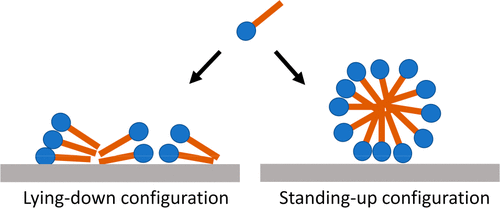当前位置:
X-MOL 学术
›
J. Phys. Chem. B
›
论文详情
Our official English website, www.x-mol.net, welcomes your
feedback! (Note: you will need to create a separate account there.)
A Quantitatively Accurate Theory to Predict Adsorbed Configurations of Asymmetric Surfactant Molecules on Polar Surfaces.
The Journal of Physical Chemistry B ( IF 2.8 ) Pub Date : 2020-06-08 , DOI: 10.1021/acs.jpcb.0c02681 Xueying Ko 1 , Sumit Sharma 1
The Journal of Physical Chemistry B ( IF 2.8 ) Pub Date : 2020-06-08 , DOI: 10.1021/acs.jpcb.0c02681 Xueying Ko 1 , Sumit Sharma 1
Affiliation

|
We introduce a theoretical model that predicts adsorbed configurations of asymmetric surfactant molecules on polar surfaces. This model extends the ideas developed in our previous work for predicting adsorbed configurations of linear surfactant molecules on polar surfaces. The surfactant molecules have a large polar headgroup and a linear alkyl tail. These asymmetric molecules form cylindrical/spherical morphologies in the adsorbed state. Our model predicts that the molecules adsorb either with their molecular axis parallel to the surface (lying-down configuration) or perpendicular to the surface (standing-up configuration). The standing-up and lying-down configurations result in significantly different adsorbed morphologies. In the standing-up configuration, the adsorbed morphology is like that of full cylinders, while, in the lying-down configuration, the adsorbed morphology resembles partial spheres. The standing-up configuration is obtained when the strength of interaction of the polar headgroup with the surface dominates over the interactions of the alkyl tail with the surface. When interactions of the alkyl tail are dominant, the molecules attain the lying-down configuration. Predictions from the theoretical model quantitatively match the results obtained from Langevin dynamics simulations. The theoretical model also explains the different kinetic pathways that have been reported in the experimental studies on the organization of adsorbed surfactants on polar surfaces.
中文翻译:

一种定量精确的理论,可预测极性表面上不对称表面活性剂分子的吸附构型。
我们介绍了一种理论模型,该模型可预测极性表面上不对称表面活性剂分子的吸附构型。该模型扩展了我们先前工作中开发的用于预测线性表面活性剂分子在极性表面上的吸附构型的想法。表面活性剂分子具有大的极性头基和线性烷基尾。这些不对称分子在吸附状态下形成圆柱/球形形态。我们的模型预测,分子以其分子轴平行于表面(躺下构型)或垂直于表面(直立构型)的方式吸附。站立和躺下的配置会导致明显不同的吸附形态。在直立状态下,吸附的形态类似于整个圆柱体,而 在躺卧状态下,吸附的形态类似于部分球体。当极性头基与表面的相互作用强度超过烷基尾部与表面的相互作用强度时,可获得立式构型。当烷基尾部的相互作用占主导时,分子将获得躺卧构型。理论模型的预测与Langevin动力学模拟获得的结果定量匹配。理论模型还解释了在极性表面上吸附的表面活性剂组织的实验研究中已报道的不同动力学途径。当极性头基与表面的相互作用强度超过烷基尾部与表面的相互作用强度时,可获得立式构型。当烷基尾部的相互作用占主导时,分子将获得躺卧构型。理论模型的预测与Langevin动力学模拟获得的结果定量匹配。该理论模型还解释了在极性表面上吸附的表面活性剂组织的实验研究中已报道的不同动力学途径。当极性头基团与表面的相互作用强度高于烷基尾基与表面的相互作用时,可获得立式构型。当烷基尾部的相互作用占主导时,分子将达到躺卧构型。理论模型的预测与Langevin动力学模拟获得的结果定量匹配。该理论模型还解释了在极性表面上吸附的表面活性剂组织的实验研究中已报道的不同动力学途径。
更新日期:2020-07-02
中文翻译:

一种定量精确的理论,可预测极性表面上不对称表面活性剂分子的吸附构型。
我们介绍了一种理论模型,该模型可预测极性表面上不对称表面活性剂分子的吸附构型。该模型扩展了我们先前工作中开发的用于预测线性表面活性剂分子在极性表面上的吸附构型的想法。表面活性剂分子具有大的极性头基和线性烷基尾。这些不对称分子在吸附状态下形成圆柱/球形形态。我们的模型预测,分子以其分子轴平行于表面(躺下构型)或垂直于表面(直立构型)的方式吸附。站立和躺下的配置会导致明显不同的吸附形态。在直立状态下,吸附的形态类似于整个圆柱体,而 在躺卧状态下,吸附的形态类似于部分球体。当极性头基与表面的相互作用强度超过烷基尾部与表面的相互作用强度时,可获得立式构型。当烷基尾部的相互作用占主导时,分子将获得躺卧构型。理论模型的预测与Langevin动力学模拟获得的结果定量匹配。理论模型还解释了在极性表面上吸附的表面活性剂组织的实验研究中已报道的不同动力学途径。当极性头基与表面的相互作用强度超过烷基尾部与表面的相互作用强度时,可获得立式构型。当烷基尾部的相互作用占主导时,分子将获得躺卧构型。理论模型的预测与Langevin动力学模拟获得的结果定量匹配。该理论模型还解释了在极性表面上吸附的表面活性剂组织的实验研究中已报道的不同动力学途径。当极性头基团与表面的相互作用强度高于烷基尾基与表面的相互作用时,可获得立式构型。当烷基尾部的相互作用占主导时,分子将达到躺卧构型。理论模型的预测与Langevin动力学模拟获得的结果定量匹配。该理论模型还解释了在极性表面上吸附的表面活性剂组织的实验研究中已报道的不同动力学途径。











































 京公网安备 11010802027423号
京公网安备 11010802027423号